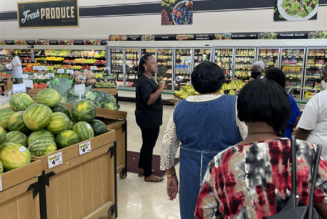In this podcast, Jennifer Smith RD, LD, CDCES, discusses healthy lifestyles for people living with Type 1 diabetes, including women’s health and the use of technology to manage the disease. She also presented on these topics at the 2023 Touched by Type 1 Annual Conference in Orlando, FL.
Additional Resources:
Touched by Type 1. Accessed December 13, 2023. https://www.touchedbytype1.org/annual-conference
For more diabetes technology content, visit the excellence forum.
TRANSCRIPTION:
Jessica Bard:
Hello, everyone, and welcome to another installment of Podcast 360, your go-to resource for medical education and clinical updates. I’m your moderator, Jessica Bard, with Consultant360, a multidisciplinary medical information network.
Nearly 1.9 million Americans have Type 1 diabetes, according to the American Diabetes Association. Registered dietician and diabetes care and education specialist, Jennifer Smith, is here to speak with us today about healthy lifestyles for people living with Type 1 diabetes, including women’s health and the use of technology to manage the disease. Jennifer, thank you for joining us on the episode today. Please tell us a little bit more about yourself.
Jennifer Smith:
Of course. Again, my name is Jennifer Smith. I’m a registered dietician and certified diabetes care and education specialist. I work with Integrated Diabetes Services with a very popular, well-known gentleman, Gary Scheiner. I work with all ages of people who have diabetes. We’re worldwide, so we provide education to people with Type 1, and Type 2 diabetes in the realm of helping them to navigate. We’ve got a wonderful crew of clinicians that I have the pleasure of working with.
I work with a lot of athletes and women with diabetes because there are certainly avenues to move down in terms of which piece of individualization needs to be done. I’ve had Type 1 diabetes myself for more than 35 years and have certainly seen a lot of the movement in the past five or 10 years in the changes and the benefits of what we now have as new technologies. I’m glad to be here. Thank you.
Jessica Bard:
Wow. Thank you so much for joining us on the podcast today. We are talking about recent conferences that you have presented at. You’ve presented at a couple. This one we’re talking about, Touched by Type 1, you presented on Healthy Living Women’s Health and Technology. If we could start with the Healthy Living presentation, can you give us an overview and some key takeaways that you gave to the audience?
Jennifer Smith:
Sure. Healthy Living, essentially, this conference provided access to management for Type 1 diabetes in all ages. I mean, there were little littles there as well as adults with Type 1 diabetes, so it really was a pleasure. This particular topic really went into many different avenues of navigating a healthy life with diabetes.
You talked about nutrition and new topics in nutrition, new sorts of ways to eat to help navigate managing blood sugar. What works? What doesn’t work? Considerations. We also really talked a lot about activity and how to navigate that. Considering Type 1 diabetes uses insulin, there’s a lot of adjustment to consider. In healthy life management with Type 1 diabetes, we’ve got exercise and activity and we’ve got the nutrition part of it. And then, the pumping or the injecting or all of the technology, that was a separate session, but some of it was touched on within this as well.
In terms of healthy living, there’s a psychological piece that gets considered. How much is too much information? I don’t necessarily think there is too much, but sometimes the overload of the technology that we use can become a lot. We touched on how and when to use our technology and when to let it lay until we’ve got an alarm or an alert that’s going off, and then we take a glance at it. In terms of life, just the patterns of growth. There were a lot of kids and parents of kids with Type 1 at the conference as well. And so, there were questions about hormones and what to expect when kids are growing and how insulin needs might change, and how to navigate all of that.
We also talked about how to transition care for kiddos who have diabetes and have been initially well-managed with their parents taking the reins. Then, also, how do you move kids to independence? What are the steps? What we really discussed, was a nice group discussion really, I emphasized the need to build as you move through years with Type 1 diabetes, build on what there’s a comfort level already. The child is able and willing and wants to put on their continuous glucose monitor, continue to let them do that.
As it goes forward, they add extra little pieces like now they do their pump insertion. Now, they’re learning where to look for things in their insulin pump or their devices. Now, they’re learning how to look at their reports. That was a big question because, growth of kids, you always want to move kids to some sort of independence even without diabetes. But because diabetes is such a 24/7, it’s really important to move kids there at their pace, but in a way that gets them out of your door eventually and independent in a good way. That was that piece of Healthy Living.
Jessica Bard:
The next was women’s health. We know this is something that you’re passionate about and quite knowledgeable about. What were the overall take-home messages and an overview of that session?
Jennifer Smith:
I presented with another educator that I work with, which was wonderful. We’ve both had Type 1 for a number of years. We’ve both had children. We’ve been pregnant with diabetes. This session, again, was filled with a lot of either teens or older women, not older but well beyond the teen years, into their adult years. Good questions in a range of things like what to expect in perimenopause and menopause, and what to think about in terms of the hormone impact of life as a female with Type 1 diabetes. That’s a piece that I’ve found there is really a lack of education.
There’s a lack of separate education when we talk about diabetes information in an office visit. Men and women, or males and females, are essentially educated about the basics in a very similar way. Until somebody notices a trend, such as a female who now starts to notice things because they’re having a monthly cycle, or based on where they are in life, it’s a missing piece that’s under-covered. I think it’s under-acknowledged, honestly. There were a lot of questions about what to expect, even from the teen parents asking, “Well, what should we expect? My preteen is in that 10 to 13-year-old time period, and I feel like I’m starting to see things that look cyclic, but they haven’t had their period yet. Is this normal?” And so, there was a lot of discussion about that.
One really interesting thing that came from that discussion, which wasn’t specific to women, but it was brought up in the session, it was about the importance of glucagon, which is that rescue product for blood sugars that are low or that are, excuse me, extremely low in order to bring that blood sugar up and help to prevent coma or death.
And so, there was a woman in that session who actually talked about the importance of that in her life as a woman with diabetes and where she felt there was an issue. But then somebody else chimed in and said, “I don’t know what you’re talking about. I’ve been diagnosed for a year.” This was a newly diagnosed adult with Type 1. She had never been told about glucagon and she was using insulin. There’s a definite deficit in insulin use and the provider aspect of, if it were up to me again, every insulin order that goes in has a pop-up message that says, “You know what? This needs glucagon as well. Write the order.” In my opinion, again, I think that’s a pretty easy thing to make an adjustment to a system. But that was a really interesting piece though. It wasn’t specific to women’s health. It got brought up in the session and it just really made me think harder about how often that is missed in providing when people use insulin.
Jessica Bard:
Last but not least, technology, and what were the overall take-home messages and just an overall summary of your presentation on technology?
Jennifer Smith:
The technology was mainly within, again, a sort of a Q&A type of technology session, especially with teens. It offered the ability to really touch base and see what kind of technology is being used. How are you using it? What are your questions about using it? Today, we have very smart insulin pump systems and, if chosen, they all work with a continuous glucose monitor. There even as I, again, have mentioned previously, there are also smart insulin pen devices that collectively note your insulin so that you have less likelihood of overdosing, or stacking is what we call it. Stacking insulin.
A lot of the teenagers, I am really proud of them because I think, as a teen, it’s hard to talk and to voice something at that age. Once we get going with, “Hey, what pumps do you use? What problems are you having with your pump system? Or what do you do to take care of this issue?”, we really got a back-and-forth discussion, which is really nice. A lot of the questions with insulin pump systems, as far as technology centered around the type of pump and infusion set issues, what do we do if our infusion site gets clogged or damaged? What type of products do you use to apply your smart technology to your body? Our continuous glucose monitors as well as our insulin pumps have an adhesive piece that keeps it on the skin and under the skin.
For some people, it works from one product to the next and other people can only use one type of product. And so, there are lots of sticky things and there are lots of sort of adhesive removers and those types of things that we were able to figure out some idea of what works person to person. “Oh, I’ve tried this,” and, “Oh, I’ve tried that and this works really well for me.” Even tricks for using their systems to a quality degree. The ability to adjust this way for exercise or activity, this way to adjust again during growth cycles. Those were a lot of the questions that came in this session with technology too, because thankfully with smarter systems, we’ve got insulin pumps that can augment that insulin delivery based on the trend in glucose. And so, looking at that is a nice way to be able to say, “Well, goodness, I see this growth happening. I see this. How can I help the system to help my child or my teenager or myself a little bit better?”
The biggest takeaways were, I think, the bringing together of people for a discussion session that is mentored by an educator is just unbelievably valuable. It helps people to think of things outside of what their own day-to-day has been like, and to give them options that maybe they weren’t even considering before. Something to go back to their clinician about and be able to say, “You know what? I heard about this and I think that this fits my lifestyle a little bit better than what I’m using. Can I try this?”, or, “What would it look like?” That session was very nice.
We talked a little bit about apps as a technology as well. Mostly apps for tracking things and also apps for, the big one is always carbohydrate counting. What are the coolest apps that I can use that are the easiest to thumb through the information and get what I need in order to be able to take my insulin and get the right amount of insulin? A number of apps were discussed and brought up for different reasons in that technology session.
Jessica Bard:
Thank you so much for joining us on the podcast today.
Jennifer Smith:
Of course. Thank you.
Jessica Bard:
For more diabetes technology content, visit consultant360.com.








